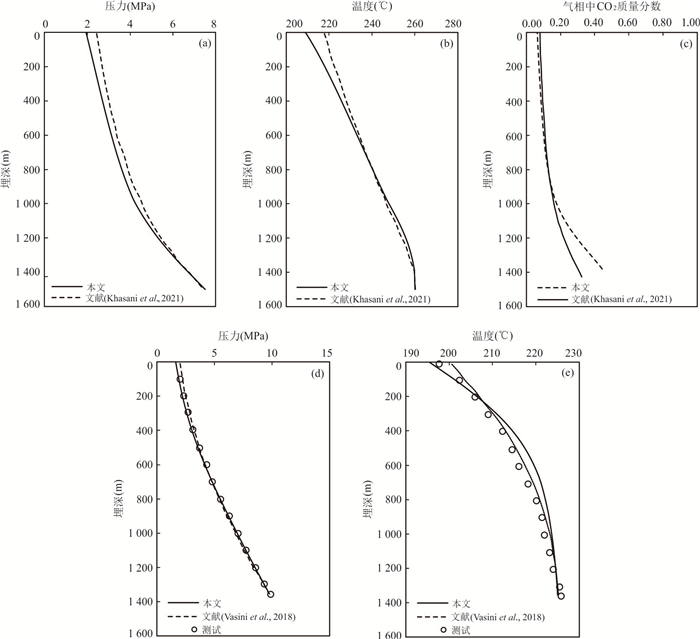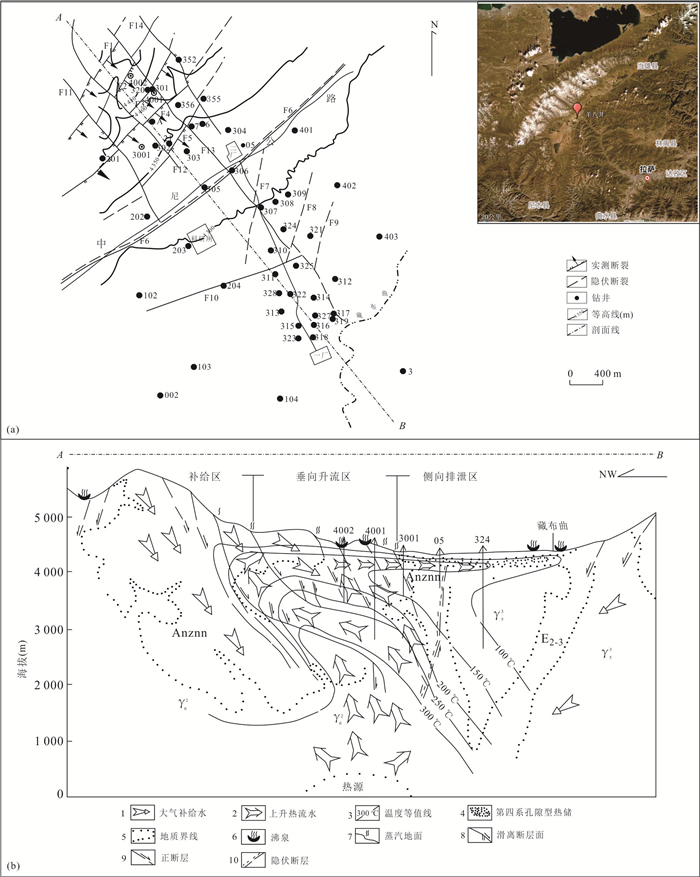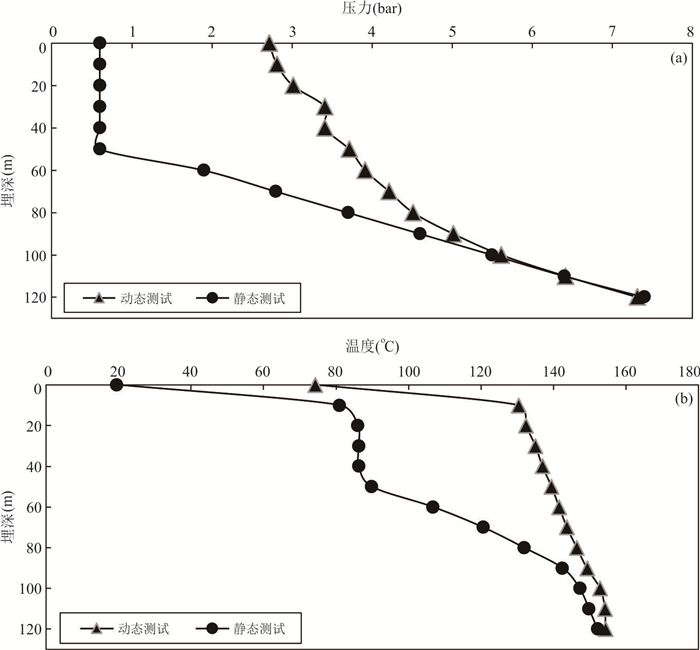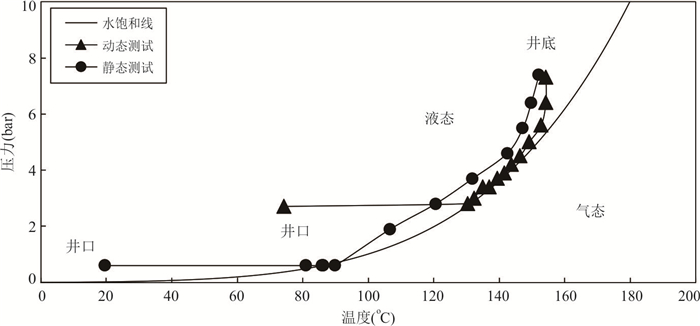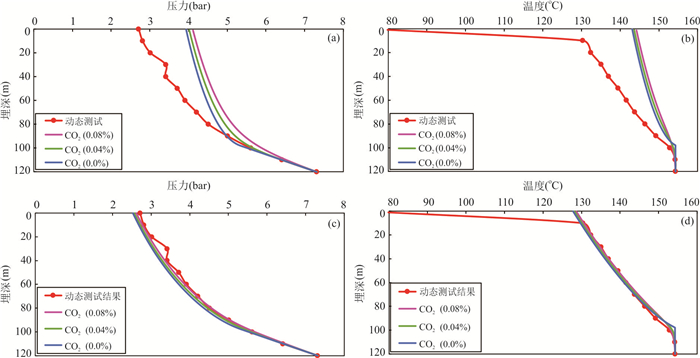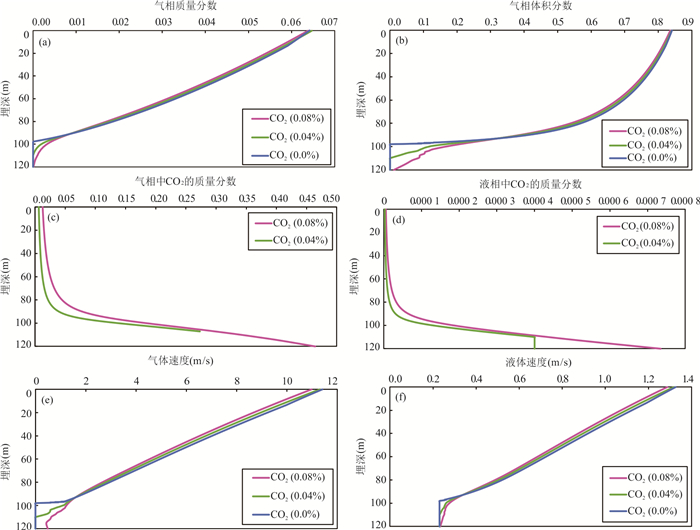Quantitative Assessment of Calcite Scaling of a High Temperature Geothermal Production Well: Two-Phase Flow—Application to the Yangbajing Geothermal Fields, Tibet
-
摘要: 高温地热生产井碳酸钙结垢定量评价涉及到复杂的物理和化学过程,其中井筒中的两相流研究是评价的基础.本文首先基于质量守恒、能量守恒和动量守恒方程,建立了CO2-H2O体系井筒两相相变稳定流动模型,提出了稳健的求解方法,并验证了其计算结果的可靠性.然后,在西藏羊八井地热田典型井开展了静止和放喷状态下的井筒中的温度和压力测试,并结合放喷试验,采用开发的模型成功评价了高温地热生产井筒两相流动过程.结果显示:气相和液相之间的速度差对井筒中温度和压力的分布有决定性的影响,不考虑气相和液体之间的速度差,会使模型计算结果远远偏离测量值.在开采速率19.10 kg/s的条件下,计算的井口温度和压力分别约为128 ℃和2.6 bar;井口的气相质量分数在6%~7%之间,对应的井口气相饱和度约为0.84;从闪蒸点往上大概20~30 m气相和液相中CO2质量分数变化较为剧烈,也是碳酸钙结垢严重井段.Abstract: The quantitative evaluation of calcite scaling in high temperature geothermal production wells involves complex physical and chemical processes, in which the two-phase flow in the wellbore is the basis for the evaluation. Based on mass, energy and momentum conservations, this paper firstly constructs a model for governing the two-phase steady flow with phase transition in the presence of CO2 in the wellbore. A robust calculation method is presented and the calculation is validated. Then the temperature and pressure measurements in a typical geothermal well were carried out during discharge tests including static and dynamic test in the Yangbajing geothermal field, Tibet. Combined with the discharge test, the model is successfully used to evaluate the two-phase flow process in a high temperature production well. The results show that the velocity difference between the gas and liquid phase has a decisive impact on the profiles of temperature and pressure in the wellbore. If the velocity difference is not considered in the model, the calculations will deviate far from the measurements. At the production rate of 19.10 kg/s, the calculated wellhead temperature and pressure are about 128 ℃ and 2.6 bar, respectively. The wellhead gas mass fraction is between 6% and 7%, and the corresponding gas phase saturation is about 0.84. The CO2 mass fractions in both gas and liquid phases change sharply about 20-30 m up from the flash point, indicating that serious calcite scaling will occur in this well section.
-
Key words:
- geothermal energy /
- two-phase flow /
- CO2 /
- numerical simulation /
- Yangbajing /
- hydrogeology
-
图 2 程序可靠性验证:(a)、(b)和(c)为与Khasani et al.(2021)的对比,(d)和(e)为与T2Well-EWASG(Vasini et al., 2018)的对比
Fig. 2. Verification of the code: comparison (a, b and c) with Khasani et al.(2021) and comparison (d and e) with T2Well-EWASG(Vasini et al., 2018)
图 3 研究区位置和地质概况:(a)平面,(b)剖面
根据许多龙等(2018)和多吉(2003)修改
Fig. 3. The location and geological profile of the study area: (a) plan, (b) cross section
表 1 井口蒸汽组分特征(Zhao et al., 1998)
Table 1. Wellhead steam composition characteristics (Zhao et al., 1998)
井名 蒸汽中CO2含量
(mmol/kg)非凝析气体体积含量(%) CO2 N2 O2 H2S H2 Ar ZK303 66.1 (0.29%)a 92.7 5.02 0.92 0.23 0.034 0.14 ZK304 26.4 (0.12%) a 93.8 4.67 0.47 0.33 0.041 0.47 ZK309 34.0 (0.15%) a 85.7 11.7 2.28 0.27 0.028 0.21 ZK313 21.6 (0.10%) a 81.3 15.6 1.96 0.43 0.035 0.23 ZK325 21.4 (0.10%) a 92.5 6.17 0.59 0.22 0.035 0.16 注:数据在一个大气压下测量;a括号中的数值为换算的CO2质量分数. 表 2 流动模型参数
Table 2. Model parameters for flow
参数 取值 井筒套管长度(m) 120 井筒直径(m) 0.34 套管底部位置压力(bar) 7.31 套管底部位置温度(℃) 154.3 质量速率(kg/s) 19.10 套管底部位置CO2质量分数 三种情况:饱和CO2含量,饱和CO2含量的一半和没有CO2 套管摩擦系数(m) 4.5×10-5 -
Barelli, A., Corsi, R., Del Pizzo, G., et al., 1982. A Two-Phase Flow Model for Geothermal Wells in the Presence of Non-Condensable Gas. Geothermics, 11(3): 175-191. https://doi.org/10.1016/0375-6505(82)90026-8 Battistelli, A., Calore, C., Pruess, K., 1997. The Simulator TOUGH2/EWASG for Modelling Geothermal Reservoirs with Brines and Non-Condensible Gas. Geothermics, 26(4): 437-464. https://doi.org/10.1016/S0375-6505(97)00007-2 Bertani, R., 2012. Geothermal Power Generation in the World 2005-2010 Update Report. Geothermics, 41: 1-29. https://doi.org/10.1016/j.geothermics.2011.10.001 Bu, X. B., Guo, Z. P., Wang, L. B., 2021. Process Simulation of Geothermal Fluid Flow in Wellbore and Calcium Carbonate Scaling. Advances in New and Renewable Enengy, 9(5): 434-442 (in Chinese with English abstract). doi: 10.3969/j.issn.2095-560X.2021.05.010 China Geological Survey of Natural Resources Ministry, Department of New and Renewable Energy of National Energy Administration, Chinese Academy of Science and Technolgy for Development, et al., 2018. China Geothermal Energy Development Report (2018). China Petrochemical Press, Beijing (in Chinese). Duo, J., 2003. The Basic Characteristics of the Yangbajing Geothermal Field: A Typical High Temperature Geothermal System. Engineering Science, 5(1): 42-47 (in Chinese with English abstract). Gunn, C., Freeston, D., 1991. An Integrated Steady-State Wellbore Simulation and Analysis Package. The 13th New Zealand Geothermal Workshop. Auckland. Guo, Q. H., Wang, Y. X., 2009. Trace Element Hydrochemistry Indicating Water Contamination in and around the Yangbajing Geothermal Field, Tibet, China. Bulletin of Environmental Contamination and Toxicology, 83(4): 608-613. https://doi.org/10.1007/s00128-009-9812-7 He, Y. J., Liu, X., Xing, L. X., et al., 2021. Scaling Process Simulation and Anti-Scaling Measures of Karst Geothermal Field in Baoding of Hebei. Earth Science Frontiers, 29(4): 430-437 (in Chinese with English abstract). Khasani, Deendarlianto, Itoi, R., 2021. Numerical Study of the Effects of CO2 Gas in Geothermal Water on the Fluid-Flow Characteristics in Production Wells. Engineering Applications of Computational Fluid Mechanics, 15(1): 111-129. https://doi.org/10.1080/19942060.2020.1862709 Lei, H. W., Bai, B., Cui, Y. X., et al., 2023. Quantitative Assessment of Calcite Scaling of a High Temperature Geothermal Production Well: Hydrogeochemistry—Application to the Yangbajing Geothermal Fields, Tibet. Earth Science, 48(3): 935-945 (in Chinese with English abstract). Lei, H. W., Cai, Y. N., Lu, M., et al., 2020. A Study on the Thermal-Hydrodynamical-Coupled CO2 Flow Process in the Ordos CCS-Geological-Formation. International Journal of Greenhouse Gas Control, 95: 102999. https://doi.org/10.1016/j.ijggc.2020.102999 Lu, M., Connell, L. D., 2014a. The Transient Behaviour of CO2 Flow with Phase Transition in Injection Wells during Geological Storage-Application to a Case Study. Journal of Petroleum Science and Engineering, 124: 7-18. https://doi.org/10.1016/j.petrol.2014.09.024 Lu, M., Connell, L. D., 2014b. Transient, Thermal Wellbore Flow of Multispecies Carbon Dioxide Mixtures with Phase Transition during Geological Storage. International Journal of Multiphase Flow, 63: 82-92. https://doi.org/10.1016/j.ijmultiphaseflow.2014.04.002 Lund, J. W., 2008. Development and Utilization of Geothermal Resources. In: Goswami, D. Y., Zhao, Y., eds., Proceedings of ISES World Congress 2007 (Vol. I-Vol. V). Springer, Berlin, Heidelberg. https://doi.org/10.1007/978-3-540-75997-3_13 Lund, J. W., Freeston, D. H., Boyd, T. L., 2011. Direct Utilization of Geothermal Energy 2010 Worldwide Review. Geothermics, 40(3): 159-180. https://doi.org/10.1016/j.geothermics.2011.07.004 Pan, L. H., Oldenburg, C. M., 2014. T2Well—An Integrated Wellbore-Reservoir Simulator. Computers & Geosciences, 65: 46-55. https://doi.org/10.1016/j.cageo.2013.06.005 Shi, H., Holmes, J. A., Durlofsky, L. J., et al., 2005. Drift-Flux Modeling of Two-Phase Flow in Wellbores. SPE Journal, 10(1): 24-33. https://doi.org/10.2118/84228-pa Vasini, E. M., Battistelli, A., Berry, P., et al., 2018. Interpretation of Production Tests in Geothermal Wells with T2Well-EWASG. Geothermics, 73: 158-167. https://doi.org/10.1016/j.geothermics.2017.06.005 Wang, G. L., Zhang, W., Liang, J. Y., 2017. Evaluation of Geothermal Resources Potential in China. Acta Geoscientica Sinica, 38(4): 449-459 (in Chinese with English abstract). Wang, X. W., Wang, T. H., Gao, N. A., et al., 2022. Formation Mechanism and Development Potential of Geothermal Resource along the Sichuan-Tibet Railway. Earth Science, 47(3): 995-1011 (in Chinese with English abstract). Xu, D. L., Jing, T. Y., Tan, J. Q., 2018. Analysis of Production Wells Monitoring and Its Impacts in Yangbajing Geothermal Field. Sino-Global Energy, 23(12): 22-28 (In Chinese with English abstract). Zhang, L., Chen, S., Zhang, C., 2019. Geothermal Power Generation in China: Status and Prospects. Energy Science & Engineering, 7(5): 1428-1450. https://doi.org/10.1002/ese3.365 Zhao, P., Duo, J., Liang, T. L., et al., 1998. Characteristics of Gas Geochemistry in Yangbajing Geothermal Field, Tibet. Chinese Science Bulletin, 43(21): 1770-1777. https://doi.org/10.1007/BF02883369 Zhou, D. J., 2003. Operation, Problems and Countermeasures of Yangbajing Geothermal Power Station in Tibet. Electric Power Construction, 24(10): 1-3, 9 (In Chinese with English abstract). Zuber, N., Findlay, J. A., 1965. Average Volumetric Concentration in Two-Phase Flow Systems. Journal of Heat Transfer, 87(4): 453-468. https://doi.org/10.1115/1.3689137 卜宪标, 郭志鹏, 王令宝, 2021. 地热流体在井筒中的流动及碳酸钙结垢过程模拟. 新能源进展, 9(5): 434-442. doi: 10.3969/j.issn.2095-560X.2021.05.010 自然资源部中国地质调查局, 国家能源局新能源和可再生能源司, 中国科学院科技战略咨询研究院, 等, 2018. 中国地热能发展报告(2018). 北京: 中国石化出版社. 多吉, 2003. 典型高温地热系统: 羊八井热田基本特征. 中国工程科学, 5(1): 42-47. https://www.cnki.com.cn/Article/CJFDTOTAL-GCKX200301007.htm 何雨江, 刘肖, 邢林啸, 等, 2021. 河北保定岩溶地热结垢过程模拟及防垢对策. 地学前缘, 29(4): 430-437. https://www.cnki.com.cn/Article/CJFDTOTAL-DXQY202204035.htm 雷宏武, 白冰, 崔银祥, 等, 2023. 高温地热生产井碳酸钙结垢定量评价: 水文地球化学——以西藏羊八井为例. 地球科学, 48(3): 935-945. 王贵玲, 张薇, 梁继运, 等, 2017. 中国地热资源潜力评价. 地球学报, 38(4): 449-459. https://www.cnki.com.cn/Article/CJFDTOTAL-DQXB201704002.htm 汪新伟, 王婷灏, 高楠安, 等, 2022. 川藏铁路沿线地热资源形成机理与开发潜力, 地球科学, 47(3): 995-1011. doi: 10.3799/dqkx.2022.059 许多龙, 荆铁亚, 谭金群, 2018. 羊八井热田生产井监测及变化影响分析. 中外能源, 23(12): 22-28. https://www.cnki.com.cn/Article/CJFDTOTAL-SYZW201812004.htm 周大吉, 2003. 西藏羊八井地热发电站的运行、问题及对策. 电力建设, 24(10): 1-3, 9. https://www.cnki.com.cn/Article/CJFDTOTAL-DLJS200310001.htm -









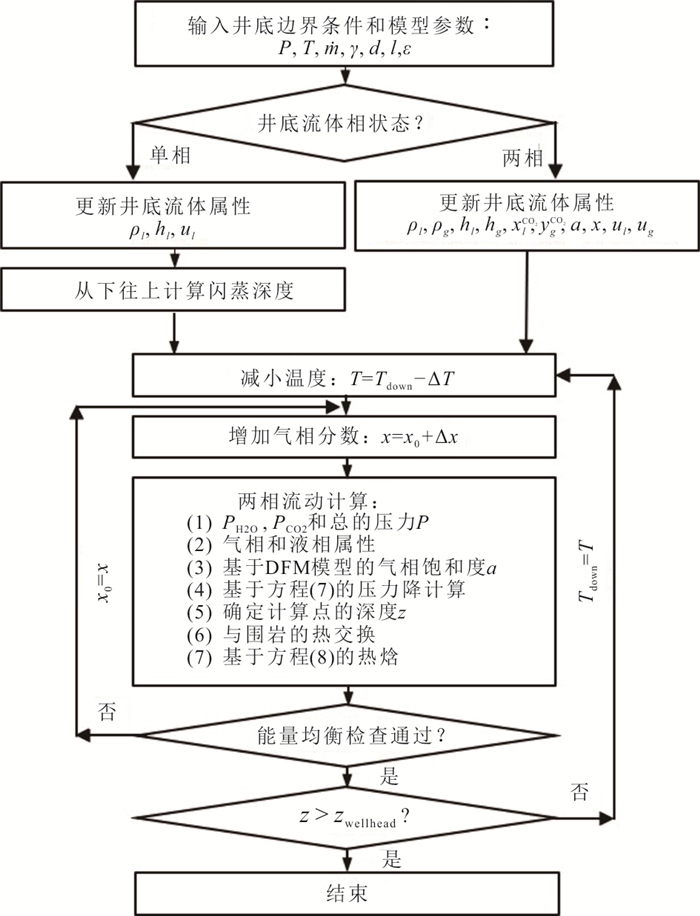
 下载:
下载:
